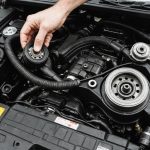Importance of Assessing Vehicle Frame Integrity
Understanding vehicle frame integrity is essential for maintaining accident safety and proper vehicle performance. When a car’s frame is compromised, the risks multiply. A sturdy frame ensures that in the event of a collision, the vehicle can absorb and distribute the impact more effectively, reducing harm to occupants. If integrity is compromised, the frame might not manage impact forces adequately, leading to increased injury risks.
The structural evaluation of a vehicle’s frame provides insights into lurking dangers that might not be immediately visible. A weakened or damaged frame could lead to unexpected vehicle behaviour, such as poor steering response or uneven tyre wear, affecting your control of the vehicle. Ensuring the frame is sound allows the car to maintain its designed performance levels, contributing to safer driving conditions.
In the same genre : Essential Safety Tips for Performing an Electrical System Inspection on Hybrid Vehicles
In addition, inspecting the frame integrity helps identify hidden issues that might affect the car’s resale value. By conducting regular checks and evaluations, potential problems can be identified and addressed early. Always ensuring proper maintenance of a vehicle’s frame enhances longevity, safety, and performance, providing peace of mind to drivers and passengers alike.
Key Techniques for Evaluating Vehicle Frame Integrity
Evaluating a vehicle’s frame integrity involves multiple assessment techniques to ensure a thorough analysis. Here, we focus on how these methods can be practically applied in real-world scenarios.
Also to read : Step-by-Step Guide: How to Safely Change the Serpentine Belt in Your SUV
Visual Inspection
Frame inspection begins with visual inspection, a critical first step in damage evaluation. This involves assessing visible signs of damage such as bends, cracks, or rust. Technicians must carefully examine all angles and sections of the frame for any irregularities or deformities, noting any apparent issues that might indicate compromise in the vehicle’s structural integrity.
Measuring Techniques
Following the visual inspection, precise measuring techniques are employed. This is essential to verify frame straightness. Measurements are taken using tools like calipers or laser measurement devices to compare the current dimensions with the manufacturer’s specifications. Accurate measurements help in identifying any subtle deviations or weaknesses that are not visible to the naked eye.
Frame Alignment Tools
Specialized frame alignment tools are essential when conducting a more in-depth damage evaluation. These advanced tools include frame machines and computerised systems that can realign and adjust frame settings to their proper alignment. By utilising such tools, even minor misalignments can be corrected, ensuring that the vehicle operates safely and efficiently.
Tools Required for Assessment
Conducting a frame integrity assessment in the automotive sector necessitates a thoughtful approach to selecting the appropriate tools. These include both general mechanics tools and more specialized assessment tools. A primary consideration is ensuring access to inspection equipment that allows for precise evaluation. Essential tools often include:
- Measuring devices such as digital calipers for accurate dimensional assessments.
- Alignment systems that provide detailed reports on frame straightness.
- Advanced scanners, particularly for newer models requiring computer-aided evaluation.
- Support stands and pads that stabilize vehicles during inspections.
Selecting between specialized tools and general ones depends significantly on the specific needs of the task. While general tools might suffice for minor assessments, specialized tools provide precision and efficiency for in-depth analysis. However, the high cost of these advanced tools can be a concern. Thus, purchasing or renting options are viable strategies.
For those in infrequent need of such equipment, renting from equipment suppliers may be cost-effective. In contrast, regular users could consider purchasing as an investment in quality and accuracy. Ultimately, having access to appropriate tools is crucial to ensure accurate and efficient frame integrity assessments.
Step-by-Step Assessment Process
Understanding the evaluation process is crucial for assessing any structural damage effectively. By framing assessment steps meticulously, one ensures a comprehensive and systematic approach.
Initial Damage Assessment
Begin with a visible damage inspection, carefully noting any obvious issues. This includes identifying cracks, displacements, or any corrosion. An inspection checklist is essential to cover all possible areas of concern. It may encompass checking doors, windows, and any visible utilities to ensure they function correctly. Assessing visible signs helps prioritize areas needing immediate attention.
Detailed Structural Evaluation
Proceed to a detailed structural evaluation. This step involves a more in-depth investigation of the fundamental elements, such as beams, columns, and load-bearing walls. Verify the alignment, levels, and integrity through methods like laser scanning or using a plumb line. Evaluators should use advanced tools to measure stress and assess potential weaknesses in structural components. This step ensures that previously undetected damages are found and logged.
Final Report and Recommendations
The final stage is compiling a report based on findings. This document should summarize all observed damages, categorize their severity, and suggest recommendations for repair. Guidance on preparing a report could include visual guides and detailed photographic evidence to support assertions. This comprehensive report aids in decision-making, providing a clear path for restoration or improvement.
Common Indicators of Frame Damage
Experiencing a vehicular accident often raises concerns about potential frame damage, a condition that threatens the structural integrity of a vehicle. Identifying damage signs early is crucial for ensuring safety.
Visual indicators are often the first clue. Common telltale signs include visible distortions, dents, and creases, particularly around the doors, hood, or trunk. Misalignment is another critical indicator; if your car veers to one side without steering input, it may suggest a compromised frame that demands immediate accident assessment.
It’s crucial to be aware of subtle warning signs that might not seem significant at first glance. Listen for unusual noises or vibrations while driving and note any difficulty in steering or handling. These symptoms could point to deeper structural issues that may not be immediately visible.
Recognizing these signs and seeking professional advice ensures that any potential damage is evaluated before it worsens. Prompt action can prevent further complications and preserve your vehicle’s overall safety and functionality. While obvious damage signs require immediate attention, subtle indicators should not be overlooked. Monitoring these symptoms guarantees a thorough understanding of your vehicle’s condition post-accident.
Expert Tips for Accurate Assessment
Gaining automotive expertise is essential for precise vehicle evaluations. Whether you’re consulting a professional or tackling a DIY assessment, understanding when to seek professional advice and how to perform personal inspections are critical.
Consulting Professionals
Opting for professional advice is wise when dealing with complex vehicle issues. Experts possess in-depth knowledge and tools that ensure a thorough evaluation. Regular professional assessments help in maintaining your vehicle’s optimal performance and identifying problems early.
DIY Techniques
For those with some automotive expertise, DIY methods can be effective. Begin by familiarising yourself with the vehicle’s manual and always utilise appropriate tools for each task. Ensure you’re aware of common assessment tips regarding the vehicle model you’re inspecting. This will guide you in identifying potential issues without dismantling complex components.
Safety Precautions
Prioritising safety cannot be overstressed. Establish a secure environment before starting an inspection. Tasks like lifting the vehicle require sturdy jacks and supporting stands. When in doubt, seek professional advice to avoid accidents. Always consider the limits of your expertise and remember that not all issues can be resolved through DIY methods. Regular assessments with safety as a focal point can lead to a more accurate appraisal of your vehicle’s condition.
Legal Implications of Frame Integrity
Navigating the legal considerations of vehicle frame integrity involves understanding various vehicle safety regulations and accident liability issues. After an incident, it’s essential to assess if your vehicle adheres to legal safety standards. These regulations ensure that any damage, particularly to the vehicle frame, doesn’t compromise passenger safety. Failure to comply might lead to legal complications.
Accident liability is intricately connected to the condition of the vehicle. If frame damage is present, it could affect the outcome of insurance claims. Insurers may require detailed assessments to determine fault and the extent of frame damage. In some cases, frame damage might influence liability determinations significantly, affecting any compensation received.
Post-accident, compliance with safety regulations becomes crucial. Ensuring your vehicle’s frame meets regulatory standards is not only legally required but crucial for ensuring your safety and that of others on the road. Ignoring these regulations can result in severe consequences, including fines or legal action. It’s vital to stay informed and proactive about maintaining frame integrity after any accident to mitigate potential legal risks.
Recommendations for Professional Services
Engaging professional assessments when dealing with repairs is crucial for ensuring effective solutions. These experts have the necessary training to identify issues that may not be immediately apparent and provide valuable insights into the repair process.
Choosing the Right Service
Selecting the appropriate service provider requires consideration of key factors. Seek automotive specialists with proven expertise in working with similar cases. Verifying credentials and customer reviews is essential to establish trust in their ability to deliver quality work. Investigate their previous projects to gauge their capability.
Understanding Repair Options
When it comes to repair services, numerous options exist depending on the damage’s complexity. Common methods include realignment for minor issues and full replacement for severely compromised structures. Each repair has specific benefits and potential limitations. Consult with professionals to understand which option aligns best with your needs and budget.
Questions to Ask Professionals
To make informed decisions, prepare a set of questions for repair specialists. Inquire about their experience with damages similar to yours. Ask about the estimated timelines for completion and anticipated costs to ensure there are no surprises. Understanding their approach to repair can reveal how they maintain quality. This dialogue ensures transparency and helps you choose services that match your expectations.











